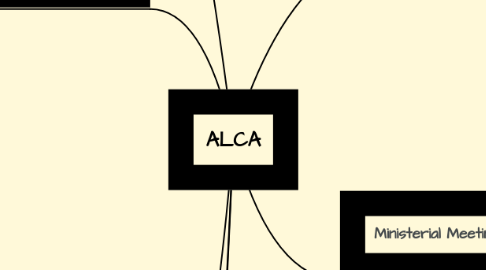
1. Second Summit of the Americas 1998, Clile
1.1. Negotiation processes should take into account differences in levels of development and size of the American economy.
1.2. * Raise the standard of living. * Improve working conditions of all the peoples of America. * Environmental Protection.
2. Third Summit of the Amercias 2001, Quebec
2.1. first publication of the first draft of the ALCA agreement in 4 official languages (July 3, 2001)
2.2. deadline for the implementation of the agreement (2005)
3. ORGANIZATION
3.1. Presidency
3.1.1. Rotating every 18 months
3.2. Trade Negotiations Committee
3.2.1. Directs the work of the negotiating groups
3.3. Negotiating Groups
3.3.1. Market Access, Colombia
3.3.2. Investments, Costa Rica
3.3.3. Government Procurement, United States
3.3.4. Dispute Settlement, Chile
3.3.5. Farming, Argentina
3.3.6. Intellectual Property, Venezuela
3.4. Advisory group of small economies
4. BENEFITS AND DISADVANTAGES
4.1. BENEFITS
4.1.1. * Elimination of trade barriers to achieve more open and transparent markets
4.1.2. * Elimination of investment boom arms
4.1.3. * Economic integration
4.1.4. *' Funding from the private sector and international financial institutions
4.1.5. * Raising the living standards of developing countries.
4.1.6. * Improve working conditions of the peoples of the Americas
4.1.7. * Better protect the environment
4.1.8. * Supplementing existing unilateral and multilateral agreements
4.1.9. * Creation of mechanisms to promote and protect investment flows
4.1.10. * Funding to help foreign debt that stops development in different countries
4.1.11. * Improving the exercise of democratic rights of indigenous peoples and their access to social services.
4.1.12. * Strengthening the role of women in all aspects of political, social and economic life
4.2. DISADVANTAGES
4.2.1. * Establishment of high levels of discipline
4.2.2. * Establishment of superiority according to the constitutions of the various countries
4.2.3. * Exploitation of labor from poor countries. (NAFTA) Deseempleo for developed countries
4.2.4. * Deforestation of indigenous areas for the establishment of oil industries
4.2.5. * May not exist in the country health or environmental restrictions for the entry of products
4.2.6. * Struggles with companies since the ALCA prohibits monopolization
5. FREE TRADE AGREEMENTS
5.1. NAFTA (MEXICO, CANADA, UNITED STATES 1994)
5.2. DR-CAFTA (Dominican Republic-Central America Free Trade Agreement)
5.3. United States – Peru Trade Promotion Agreement (2006)
5.4. Colombia Trade Promotion Agreement (TPA) 2011
5.5. United States-Chile Free Trade Agreement 2003
5.6. Pacific Alliance (Chile, Colombia, México y Peru)
6. Summit of the Americas 1994, Miami, United States
6.1. Progressively eliminate barriers to trade and investment
7. Ministerial Meetings
7.1. PREPARATION PHASE
7.1.1. * 1995 Denver, United States
7.1.2. * 1996 Cartagena, Colombia
7.1.3. * 1997 Belo Horizonte, Brasil
7.1.4. * 1998 San José, Costa Rica
7.2. DEVELOPMENT
7.2.1. * 1999 Toronto, Canada
7.2.2. * 2001 Buenos Aires, Argentina
7.2.2.1. Creation of the Technical Committee for International Affairs and the Committee of Government Representatives on Civil Participation.
7.2.3. * 2002 Quito, Ecuador
7.2.3.1. Timetable for the exchange of initial offers of market access.
7.2.3.2. Publication of the second borador ALCA agreements
7.2.3.3. Hemispheric Cooperation Program (HCP) to strengthen the capacities of those countries seeking assistance to participate in the negotiations, implement their trade commitments, and address the challenges of hemispheric integration and maximize the benefits of such integration
7.3. FINAL PHASE
7.3.1. * 2003 Miami, United States
7.3.1.1. The commitment that the ministers for the ALCA negotiations successful conclusion by January 2005, with the ultimate goal of achieving an area of free trade and regional integration reaffirms.

